
Green living is more than the new on-trend fade. Along with living a healthier lifestyle, it includes reducing overall consumption, especially with energy and resources. The majority of which can be done when you are choosing or building your home.
Although many people think, “I’ll just put solar energy on my house and it’s automatically green,” it isn’t quite that simple. A series of considerations and steps must be taken so sustainability exists throughout the home from infrastructure to appliances. Keep these questions on your eco-home cheat sheet to ensure a journey to a truly, green life will be paved with eco-friendliness: Is it sourced from renewable or recycled materials? It is efficient? Will this give me the maximum durability?
The first step is making sure you have an efficient heating and cooling system, which in turn reduces your overall need for electricity.
The idea behind the green building is to reduce your consumption as much as possible. Choosing products and materials that have long-term durability is a positive strike in the green balance. Start at minimal levels like using LED light bulbs and choosing energy star certified home appliances. The next level would be installing triple glazed windows or having high R-Value, a measurement of insulation's ability to resist heat flow through it, on your exterior walls. All of these things decrease the need for consumption.
The next area to examine is looking carefully at the ingredients that go into the ingredients. For example, choosing environmentally benign refrigerant materials that are non-ozone depleting. Explore the option of installing solar to generate the electricity that you need.
“Solar panels are generally regarded as being green, but the dirty little secret is that a lot of manufacturers use heavy metals,” says Gian-Paolo Caminiti, Regional Sales Manager at Mitsubishi.
If you have solar electricity in your house, but each panel is made with heavy metals, ask yourself these questions: What happens if those panels get damaged or need to be replaced? Can they be recycled? How are they disposed at the end of the lifecycle? Lots of manufacturers use lead based solder. One panel can have up to 58 grams of lead. According to Caminiti, companies like Mitsubishi, offer 100 percent silver-based, lead free solar panels. It increases the price but also makes it more durable. Another energy source option is installing a hydropower system if you have a source of flowing water such as a creek or stream.
Part of what makes a home vibrant and aesthetically pleasing are the color options you choose, but be sure to choose paint colors wisely. Many paints contains volatile organic compounds, or VOCs, that give off gas for weeks which have been linked to respiratory issues, cancer, nausea, and eye irritation. These conventional paints also contain toxic fungicides and biocides which can last in the air for years. Water-based paints contain 5-10 percent less VOCs than oil-based paints, which are mostly made of VOCs (40 to 60 percent). Opt for eco-friendlier, natural paints which contain terpenes, plant-based VOCs, and use natural pigments. Milk paint is also available on the market and is made with casein, a milk protein.
Some people like carpeting while others prefer wood flooring. When shopping for carpeting, choose options that use recycled content or made from renewable sources such as kenaf or bamboo. For wood flooring, consider choosing bamboo or sustainable. Wood floors are made from a variety of eco-friendly options now. Reclaimed wood uses previously manufactured wood such as wood from a deconstructed building or barn. Recycled wood fiber floors are a composition of post-industrial waste such as sawdust. Another option is FSC (Forest Stewardship Council) certified wood which ensures that the product is sourced from a well-managed forest.
These are just some of the key factors to look at when building or choosing your home.